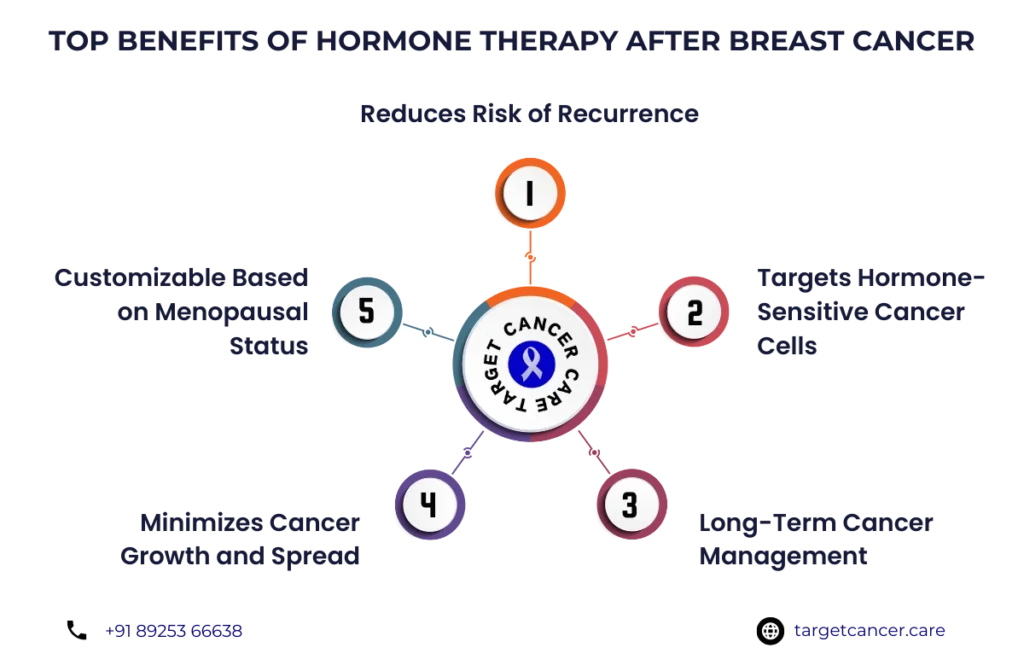Breast cancer is one of the most common types of cancer, and its treatment often requires a combination of therapies tailored to the patient’s specific condition. Hormone therapy is a vital option for treating breast cancer, particularly in cases where the cancer is hormone receptor-positive. This therapy plays a crucial role in reducing the risk of cancer recurrence and improving the overall prognosis. In this blog, we’ll explore hormone therapy for breast cancer, how it works, its different types, side effects, and the key role it plays in treating estrogen receptor-positive breast cancer.
Hormone therapy is a key treatment option for patients with hormone receptor-positive breast cancer. This therapy targets the hormonal pathways that can fuel cancer cell growth, especially in estrogen receptor positive breast cancer (ER+). Effective in reducing recurrence and slowing cancer progression, hormone therapy works by blocking or lowering estrogen and progesterone levels, hormones known to promote certain breast cancers.

What Are Hormones and Hormone Receptors?
Hormones are chemical messengers produced by glands in the body, which travel through the bloodstream to regulate various bodily functions. In breast cancer, hormones like estrogen can fuel the growth of certain types of tumors. This is where hormone receptors come into play. Hormone receptors are proteins found in and on breast cancer cells that bind to hormones, stimulating cancer growth.
For women with estrogen receptor-positive breast cancer, the cancer cells have receptors that bind to estrogen, encouraging the cancer to grow. Hormone therapy works by blocking the interaction between hormones and these receptors, reducing or halting the growth of the tumor.
What Is Hormone Therapy?
Hormone therapy for breast cancer is a treatment designed to block or lower the amount of hormones (specifically estrogen) in the body to prevent them from stimulating cancer growth. Unlike chemotherapy, which attacks all rapidly growing cells, hormone therapy specifically targets cancer cells with hormone receptors.
Hormone therapy, also called endocrine therapy, is a treatment approach designed for patients with hormone receptor-positive breast cancer. This form of therapy disrupts the hormonal influences on cancer cells, specifically in cancers that are responsive to estrogen or progesterone. By blocking these hormonal pathways, hormone therapy helps to manage, control, and prevent recurrence in breast cancer.
How Does Hormone Therapy Work?
In breast cancer, hormone-sensitive cells may rely on estrogen or progesterone to grow and divide. Hormone therapy targets these cells by either lowering hormone levels or blocking hormone receptors on the cancer cells, effectively “starving” them of what they need to grow. Hormone therapy for ER+ breast cancer specifically targets cancer cells with estrogen receptors, reducing the chances of recurrence and supporting long-term remission.
Types of Hormone Therapy for Breast Cancer:
- Selective Estrogen Receptor Modulators (SERMs): Drugs like Tamoxifen attach to estrogen receptors on cells, blocking estrogen’s influence and preventing cancer growth.
- Aromatase Inhibitors (AIs): Drugs like Anastrozole and Letrozole inhibit estrogen production in postmenopausal women by blocking the enzyme aromatase, responsible for estrogen production.
- Ovarian Suppression for Breast Cancer: Ovarian Suppression for Breast Cancer is a method used primarily in premenopausal women. By halting estrogen production at its source (the ovaries), it lowers the hormone levels circulating in the body and starves cancer cells of the hormones they need to grow.
What Types of Hormone Therapy Are Used for Breast Cancer?
There are different types of hormone therapy used to treat breast cancer, depending on the patient’s menopausal status and the specific characteristics of the cancer.
Tamoxifen
Tamoxifen is the most commonly used drug for hormone therapy after breast cancer surgery. It works by blocking Estrogen Receptor positive breast cancer cells, preventing the hormone from promoting cancer cell growth. It can be used for both premenopausal and postmenopausal women.
Aromatase Inhibitors (AIs)
For postmenopausal women, aromatase inhibitors such as anastrozole, letrozole, and exemestane are used to lower estrogen levels by blocking the enzyme aromatase, which the body uses to make estrogen. AIs are typically given after surgery or in cases of advanced breast cancer.
Ovarian Suppression
For younger, premenopausal women, Ovarian Suppression for Breast Cancer plays a crucial role in managing hormone receptor-positive breast cancer. Methods of ovarian suppression include:
- Surgical removal of the ovaries, which eliminates the main source of estrogen.
- Medication-induced suppression, such as with drugs like goserelin, which temporarily stops ovarian hormone production.
Ovarian suppression can be a standalone approach or used in conjunction with other therapies for optimal outcomes.
When Is Hormone Therapy Used for Breast Cancer?
Hormone therapy plays a critical role in managing breast cancer, particularly in cases where the cancer is hormone-sensitive. This treatment is commonly used for Estrogen Receptor Positive Breast Cancer, where the growth of cancer cells is driven by hormones like estrogen or progesterone.
Situations Where Hormone Therapy Is Recommended:
- Early-Stage Breast Cancer:
- Hormone therapy is used after surgery to reduce the risk of recurrence.
- This is especially beneficial for Estrogen Receptor Positive Breast Cancer cases.
- Advanced or Metastatic Breast Cancer:
- It helps control cancer that has spread beyond the breast and lymph nodes.
- It can slow the progression of the disease effectively.
- Preventive Use:
- In women with a high risk of developing hormone-sensitive breast cancer, hormone therapy can be used as a preventive measure.
- Hormone Therapy After Breast Cancer Treatment:
- This is crucial to ensure any remaining cancer cells are suppressed, reducing the chances of recurrence.
Hormone therapy for breast cancer is often prescribed in pill form or via injections, depending on the patient’s needs. Early detection and timely initiation of therapy can significantly improve outcomes.
Can Hormone Therapy Be Used to Prevent Breast Cancer?
Yes, hormone therapy can also be used as a preventive measure for women who are at high risk of developing breast cancer due to family history or genetic predisposition, such as BRCA mutations. Preventive hormone therapy may lower the risk of developing estrogen receptor-positive breast cancer by reducing the body’s estrogen levels or blocking its effects on breast tissue.
Drugs That Block Estrogen Receptors
Tamoxifen is the most widely recognized drug in this category, used for both treatment and prevention. Tamoxifen is a selective estrogen receptor modulator (SERM), which means it blocks estrogen’s action in breast cells but can act like estrogen in other tissues such as bones and the uterus.
Other Drugs:
- Raloxifene: Used primarily for preventing breast cancer in postmenopausal women who are at high risk.
- Toremifene: Similar to tamoxifen, this drug is another option for estrogen receptor-positive breast cancer patients.
Medicines That Stop the Body from Making Estrogen
As mentioned earlier, aromatase inhibitors are a crucial class of drugs for reducing estrogen production in postmenopausal women. These drugs prevent the enzyme aromatase from converting androgens into estrogen, thereby lowering overall estrogen levels in the body.
Some examples include:
- Anastrozole (Arimidex)
- Letrozole (Femara)
- Exemestane (Aromasin)
These medicines are typically used after surgery to reduce the risk of cancer recurrence and are often taken for five years or more.
What Is the Success Rate for Hormone Therapy for Breast Cancer?
The success rate of Hormone Therapy for Breast Cancer Treatment varies depending on factors like the stage of cancer and its hormone receptor status. On average:
- For Estrogen Receptor Positive Breast Cancer, hormone therapy can reduce the risk of recurrence by 40% to 50% in early-stage cases.
- In advanced or metastatic cases, it effectively controls the disease and improves quality of life for a significant percentage of patients.
Studies show that combining hormone therapy after breast cancer treatment with other modalities can increase survival rates and long-term outcomes.
Benefits of Hormone Therapy for Breast Cancer
Hormone therapy is an effective treatment for hormone receptor-positive breast cancer. It helps prevent recurrence and improves survival rates. Here are the key benefits of hormone therapy for breast cancer treatment:
1. Reduces the Risk of Recurrence
- Lowers the chances of cancer returning after surgery or radiation therapy.
- Helps block estrogen or progesterone, which fuels cancer cell growth.
2. Prevents Cancer from Spreading
- Slows down or stops the spread of cancer cells to other parts of the body.
- Beneficial for early-stage and advanced breast cancer cases.
3. Improves Long-Term Survival
- Enhances the effectiveness of other treatments like chemotherapy and radiation.
- Increases overall survival rates in breast cancer patients.
4. Non-Invasive & Long-Term Protection
- Taken as a daily pill or injection, making it convenient and non-invasive.
- Provides continuous protection for 5-10 years after initial treatment.
For patients seeking comprehensive care, hormone therapy for breast cancer treatment is a key part of recovery. Consulting specialists ensures the best treatment approach for long-term health.
Side Effects of Hormone Therapy for Breast Cancer
While hormone therapy is effective in treating estrogen receptor-positive breast cancer, it comes with potential side effects. These side effects vary depending on the specific drug and the patient’s menopausal status.
Common Side Effects:
- Hot Flashes: A common side effect of tamoxifen and aromatase inhibitors.
- Bone Thinning (Osteoporosis): Aromatase inhibitors reduce estrogen, which can lead to bone thinning in postmenopausal women.
- Mood Changes: Hormone therapy can lead to emotional swings or depression.
- Vaginal Dryness: Both tamoxifen and aromatase inhibitors can cause vaginal dryness and discomfort.
- Joint Pain: Patients on aromatase inhibitors may experience joint stiffness and pain.
It’s important to discuss the potential risks and benefits of hormone therapy with your doctor to ensure the best treatment approach for your specific situation.
Risks of Hormone Therapy
Although hormone therapy is an effective treatment for estrogen receptor-positive breast cancer, there are certain risks associated with its use. For example:
- Tamoxifen: While tamoxifen can reduce the risk of breast cancer recurrence, it can increase the risk of uterine cancer and blood clots.
- Aromatase Inhibitors: These drugs may increase the risk of osteoporosis and fractures due to reduced estrogen levels.
- Ovarian Suppression: Menopausal symptoms such as hot flashes, night sweats, and mood swings.
Careful monitoring by your healthcare provider can help mitigate these risks and ensure you receive the best possible care.
Conclusion
Hormone therapy remains a cornerstone in the treatment of estrogen receptor-positive breast cancer, offering significant benefits in reducing the risk of cancer recurrence and improving survival rates. While the treatment comes with potential side effects, its effectiveness in controlling cancer growth makefs it a valuable option for many women.
If you have been diagnosed with breast cancer or are at high risk, consult with the expert oncologists at Targeting Cancer, including Dr. V. Balasundaram, Dr. V M Duraimavalavan, and Dr. Saravanan Periasamy. With their extensive experience in hormone therapy for breast cancer, they can provide personalized care and guidance to help you navigate your treatment journey.




